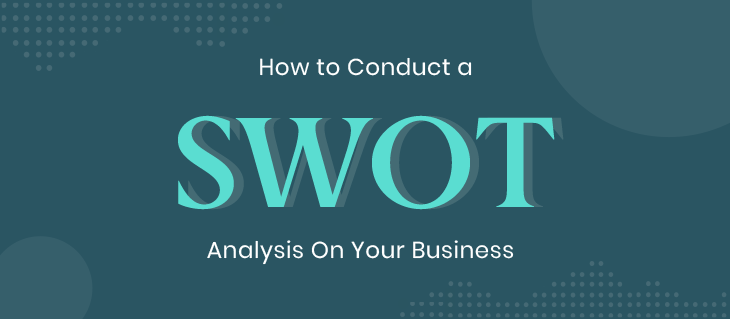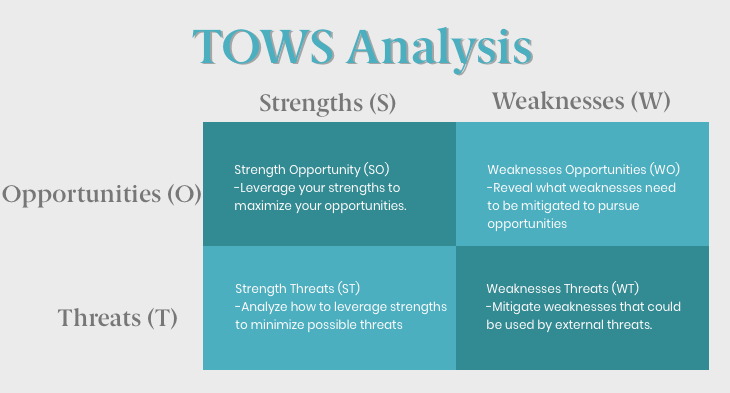What's a SWOT Analysis & Why You Should Conduct One

Take your business to the next level by conducting a SWOT Analysis.
You might be wondering what a SWOT analysis is. A SWOT analysis is a simple, yet powerful tool that can help you grow your business and adapt your strategy. SWOT stands for Strengths, Weaknesses, Opportunities, and Threats.
By conducting a SWOT you are able to see both internally and externally what is working well for your business, as well as areas that could use some improvement. It is a meaningful way to assess your company and give you actionable ways to move forward.
To best guide you through the SWOT analysis, we’ve included questions for you to ask about your business and external environment.
Strengths
Internal to your company, strengths let you look at what parts of your business are successful and the positive attributes about you that are within your control.
- What are the things your business does well?
- What advantages do your products/services have?
- What skills and knowledge does your team hold?
Weaknesses
Weaknesses are internal and are things that you can improve upon or need to work on in order to continue to grow.
- Are there processes in your business that are inefficient or need improvement?
- What factors lose you sales?
- Are their limitations to your resources?
Opportunities
Looking at your possible opportunities offers an exciting perspective of your business to see where you are able to grow your business through an external environment.
- Is the market for your product or service growing?
- What are some of the trends in your market industry? (Ie changes in technology, changing populations, and lifestyle changes)
- Is there an underserved market similar to your product/service?
Threats
External factors that you have no control over are threats to your business. This could be a new competitor, the economy, and other similar uncontrollable external factors.
- Who are your current competitors?
- Is technology threatening your current business?
- Is there a possibility for your customers to quickly change their attitude about your company?
Maybe you already know what your business does well, but when you sit down to look at how you could combine that with an opportunity, that’s where we see growth in a company. There are almost always links between what you are doing and an opportunity in the market that your business could take on.
How to Conduct a SWOT Analysis
A formal SWOT analysis works well with a diverse group of contributors. Say you own a restaurant--don’t just have the managerial team partake in the SWOT-- ask your wait staff, chefs, and other team members so that you’re able to get a view from every level of your staff. The insights provided by the front-line team may offer you new perspective and even shine light on some possible opportunities.
Put together a sheet for your team members to fill out that denotes spots for Strengths, Weaknesses, Opportunities and Threats. Ask these exploratory questions and allow your team time to brainstorm. Making the sheets or forms anonymous will allow for an open and honest discussion.
After you’ve got everyone’s answers, gather your results and put them into an overall list of Strengths, Weaknesses, Opportunities and Threats. It helps to look at this list to see if there were any surprising developments, as well as just take inventory of your team’s thoughts. It's important that as a business you are able to address any crucial concerns that come up and make sure your staff feels heard and that their opinions matter.
Actionable Ways to Move Forward
The activity of a SWOT should bring forth a good amount of information itself, but it is helpful to have some more actionable steps to move forward. If there are any glaring weaknesses brought up by your team, they should be addressed, as well as your strengths recognized and commended.
One of our favorite ways to move forward with actionable items is to rearrange your SWOT into a TOWS matrix, with Threats and Opportunities on the Y axis and Weaknesses and Strengths on the X-axis.

The TOWS analysis was developed by Fred David as a way to create actionable items from a SWOT, by combining each of the internal and external factors.
To begin, you can combine your Strengths and Opportunities. This is your SO strategy, which has you leverage your strengths in order to maximize your opportunities.
Then, you can look at Strengths and Threats in the bottom left quadrant and analyze your ST strategy. This will allow you to look at ways to leverage your strengths to minimize your possible threats.
Next, in the bottom right corner, you can look at your Weaknesses and Threats, or your WT strategy to ask yourselves, what weaknesses could be used by external threats and how you can defend against those?
Finally, your Weaknesses and Opportunities, or WO strategy, can allow you to see what weaknesses need to be mitigated in order to capitalize on your opportunities.
Overall, we see great success in using the SWOT and TOWS analyses as ways of reviewing businesses as well as revealing new opportunities and possible overlooked threats. Take the time to sit down and assess your business, then use what you've learned to move forward and take advantage of opportunities, address your threats and weaknesses, and see how you can continue to build your strengths.